Consider the following set of processes, with the length of the CPU-burst time given in milliseconds: ITTI Process Burst Time Arrival Time Priority 3 P1 10 P2 1 2 1 P3 2 1 3 Р4 1 1 4 P5 3 2 a. Sketch Gantt charts illustrating the execution of these processes using FCFS, SJF, a preemptive priority (a smaller priority number implies a higher priority), and RR (quantum = 2) scheduling. b. Compute the Turnaround time & Waiting time of each process for each of the scheduling algorithms in part-a. c. Show which of the schedules in part-a results in the minimal average waiting time(overall processes)
Consider the following set of processes, with the length of the CPU-burst time given in milliseconds: ITTI Process Burst Time Arrival Time Priority 3 P1 10 P2 1 2 1 P3 2 1 3 Р4 1 1 4 P5 3 2 a. Sketch Gantt charts illustrating the execution of these processes using FCFS, SJF, a preemptive priority (a smaller priority number implies a higher priority), and RR (quantum = 2) scheduling. b. Compute the Turnaround time & Waiting time of each process for each of the scheduling algorithms in part-a. c. Show which of the schedules in part-a results in the minimal average waiting time(overall processes)
Computer Networking: A Top-Down Approach (7th Edition)
7th Edition
ISBN:9780133594140
Author:James Kurose, Keith Ross
Publisher:James Kurose, Keith Ross
Chapter1: Computer Networks And The Internet
Section: Chapter Questions
Problem R1RQ: What is the difference between a host and an end system? List several different types of end...
Related questions
Question

Transcribed Image Text:Consider the following set of processes, with the length of the CPU-burst time given in
milliseconds:
Process
Burst Time
Arrival Time
Priority
3
P1
10
P2
1
2
1
P3
1
3
Р4
1
1
4
P5
5
3
2
a. Sketch Gantt charts illustrating the execution of these processes using FCFS, SJF, a
preemptive priority (a smaller priority number implies a higher priority), and RR (quantum = 2)
scheduling.
b. Compute the Turnaround time & Waiting time of each process for each of the scheduling
algorithms in part-a.
c. Show which of the schedules in part-a results in the minimal average waiting time(overall
processes)
Expert Solution
This question has been solved!
Explore an expertly crafted, step-by-step solution for a thorough understanding of key concepts.
Step by step
Solved in 4 steps with 3 images

Recommended textbooks for you

Computer Networking: A Top-Down Approach (7th Edi…
Computer Engineering
ISBN:
9780133594140
Author:
James Kurose, Keith Ross
Publisher:
PEARSON

Computer Organization and Design MIPS Edition, Fi…
Computer Engineering
ISBN:
9780124077263
Author:
David A. Patterson, John L. Hennessy
Publisher:
Elsevier Science

Network+ Guide to Networks (MindTap Course List)
Computer Engineering
ISBN:
9781337569330
Author:
Jill West, Tamara Dean, Jean Andrews
Publisher:
Cengage Learning

Computer Networking: A Top-Down Approach (7th Edi…
Computer Engineering
ISBN:
9780133594140
Author:
James Kurose, Keith Ross
Publisher:
PEARSON

Computer Organization and Design MIPS Edition, Fi…
Computer Engineering
ISBN:
9780124077263
Author:
David A. Patterson, John L. Hennessy
Publisher:
Elsevier Science

Network+ Guide to Networks (MindTap Course List)
Computer Engineering
ISBN:
9781337569330
Author:
Jill West, Tamara Dean, Jean Andrews
Publisher:
Cengage Learning

Concepts of Database Management
Computer Engineering
ISBN:
9781337093422
Author:
Joy L. Starks, Philip J. Pratt, Mary Z. Last
Publisher:
Cengage Learning

Prelude to Programming
Computer Engineering
ISBN:
9780133750423
Author:
VENIT, Stewart
Publisher:
Pearson Education

Sc Business Data Communications and Networking, T…
Computer Engineering
ISBN:
9781119368830
Author:
FITZGERALD
Publisher:
WILEY